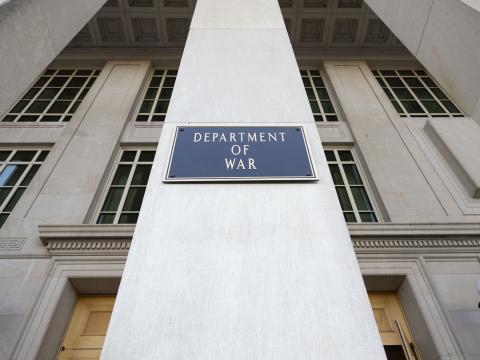MARS' Mission: Find a New Home, Continue Long-Standing Tradition of Service
The Military Auxiliary Radio System-MARS-has been a mainstay in military and civilian support communications for decades. Its value as a voluntary civilian entity under the umbrella of the ASD(NII) cannot be understated. But now that the ASD(NII) faces disbanding at the behest of Defense Secretary Gates, what does the future hold? MARS has several potential destinations, but what's the best fit? Where will MARS receive the support it requires to continue flourishing? Share your opinions and ideas here.
For decades, the military and specially trained civilian amateur radio operators of the Military Auxiliary Radio System (MARS) have provided reliable zero-cost back-up communications to the U.S. Defense Department and armed forces. This civilian-military partnership has served the nation well.
The U.S. military's reliance on sophisticated communications architectures and networks is a double-edged sword. It conveys distinct advantages to the armed forces. Yet the more sophisticated the technology, the more susceptible it becomes to unexpected failures, disruption or destruction from asymmetric threats, such as satellites' vulnerability to antisatellite warfare. Systems do fail and can be compromised. Therefore, reliable back-up communications are critical.
In both war and peace, the military has benefited from a formal partnership with nearly 5,000 volunteer licensed civilian amateur radio operators who form the backbone of MARS. Though little-known outside amateur radio circles, this relatively "low-tech" means of back-up communication has a storied record of service to the military.
In the days before cell phones, e-mail and the Internet, MARS was known for relaying messages of morale from service personnel stationed abroad. The MARS mission has evolved to support the U.S. government's post-9/11 emergency preparedness efforts. As a Defense Department-sponsored program separately managed and operated by the Army, Navy-Marine Corps and Air Force, the system has been recognized by senior Defense Department leadership and was recently reaffirmed in departmental guidance by the Office of the Secretary of Defense (OSD).
In December 2010, DoD Instruction (DoDI) 4650.02 upgraded MARS (formerly the Military "Affiliate" Radio System) to an organized military "auxiliary," tasking it with providing contingency radio communications support not only to the Defense Department but also to civil authorities at all levels, in accordance with the department's homeland defense responsibilities. In addition, the secretaries of the military departments were tasked with reporting annually to the OSD on their respective MARS programs.
In a February 2009 SIGNAL Connections article, "Amateur Radio Community Experts Crucial to Emergency Communications," I discussed how MARS could benefit from OSD's active guidance and oversight. Under the DoDI, primary policy oversight for emergency communications initiatives involving MARS was assigned to the Assistant Secretary of Defense for Networks and Information Integration (ASD[NII]). In April 2010, Acting ASD(NII) Cheryl Roby declared her strong support for the MARS program and commitment to broadening its role within the department and the combatant commands.
The NII, however, is being eliminated as a result of the "efficiency initiatives" announced by Defense Secretary Robert Gates in August. Many of its functions will be transferred to the Defense Information Systems Agency, the Undersecretary of Defense for Acquisition, Technology and Logistics or elsewhere.
Where MARS program oversight will reside after the organizational disestablishment of NII remains to be seen. But wherever it migrates, MARS operators remain ready to fulfill their contingency communications mission and to expand their relationship with the Defense Department and civil agencies.
In addition to providing high frequency (HF) radio contingency communications support to the Defense Department, MARS operators support other elements of the U.S. government. For example, they actively participate in the National Communications System Shared Resources HF Radio Program, which promotes interoperability between more than 100 federal, state and private sector entities in support of national security/emergency preparedness.
MARS members are experienced radio operators who communicate on military frequencies using both voice and digital modes. They voluntarily devote their time and resources to ensure the Defense Department has reliable contingency communications capability if needed, under all types of circumstances.
The system also works with domestic civilian and emergency response organizations at the national, state and local levels to ensure reliable communications links during emergencies. This includes use of a global network of nodes to relay e-mail traffic via HF radio when Internet connectivity is unavailable. Several state and county emergency management offices also use MARS as the link between their civilian emergency management radio nets and military radio nets activated in an emergency.
MARS operators provide support to individual military installations, as well as the National Command Authority. While MARS represents only a fraction of the communications assets and capabilities available to the Defense Department, interest has resurfaced within the military with regard to the HF radio spectrum MARS uses for the bulk of its operations. This resurgence is being channeled into a productive, expanding partnership between civilian radio operators and their uniformed counterparts, an outcome that should be encouraged and nurtured.
With new Defense Department guidance, an expanded mission, a proven record of accomplishments, and a pool of talented and capable radio operators providing their services voluntarily, MARS is a communications asset that has attracted the attention and support of senior Defense Department leaders.
Notwithstanding the uncertainties resulting from internal Defense Department decisions intended to reduce overhead, eliminate redundancies, streamline management and improve operational efficiencies, the value MARS provides to the Defense Department, civil agencies and the nation should remain strong for the foreseeable future.
David J. Trachtenberg, president and chief executive officer of Shortwaver Consulting, is a former Principal Deputy Assistant Secretary of Defense for International Security Policy and a member of Air Force MARS and SHARES.




Comment
Re : Title should be MARS
I agree with Maj. Sutphin
MARS is an operations
I can think of only one
Both Mr. Edmonds and Mr.
I think that part of the
Well, here's the problem, at
As Mr. Rodriguez notes,
I first became a MARS
Mr. Kean's observation that
Once upon a time my boss of
Once upon a time my boss of
I thought somebody would
I greatly appreciate the
Let me start out by saying I
Comments